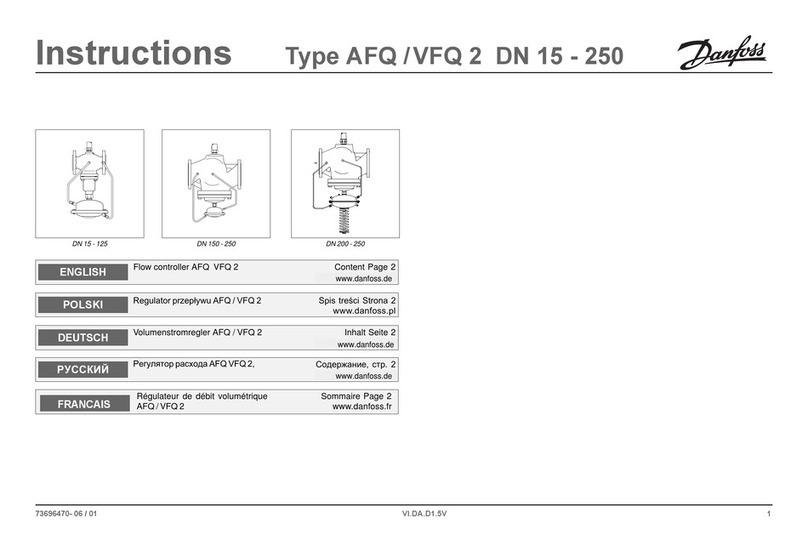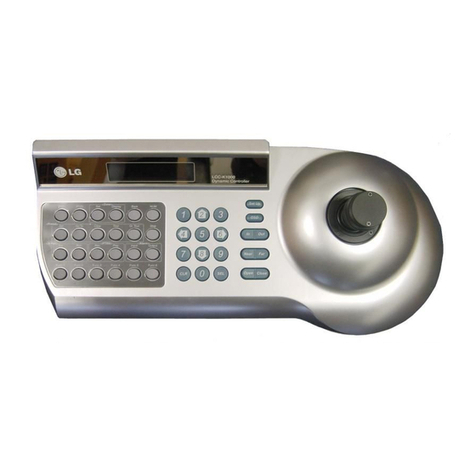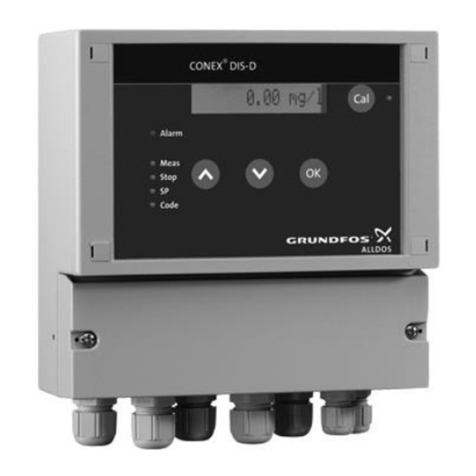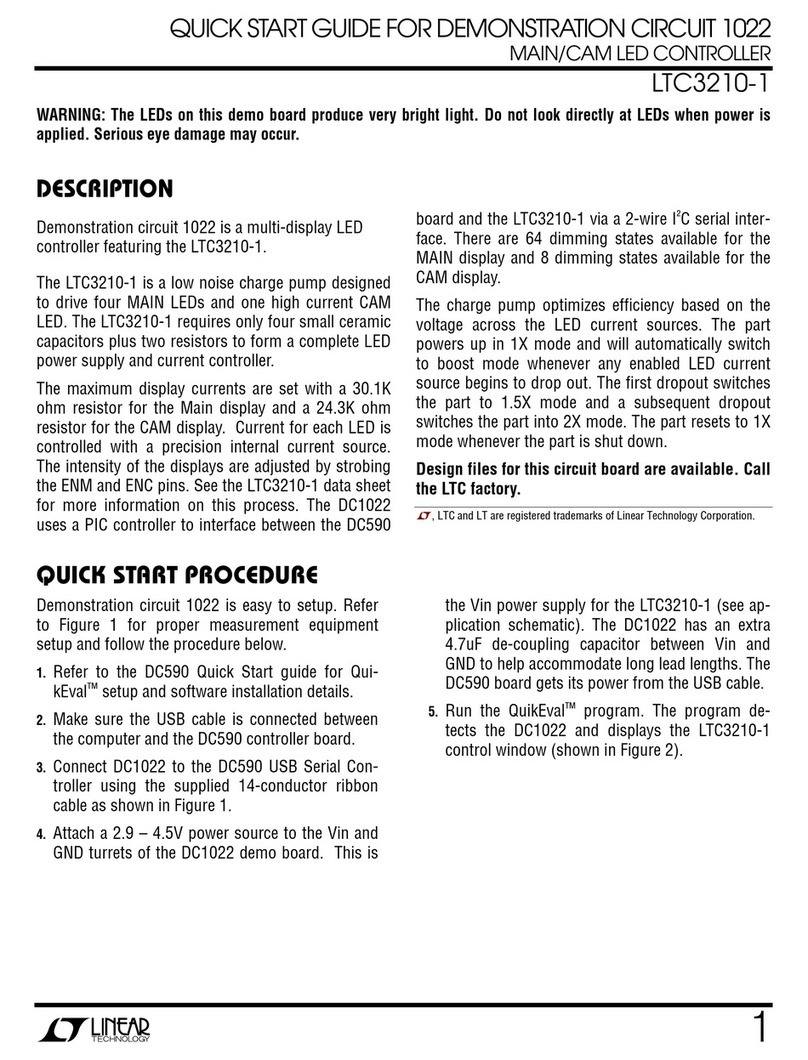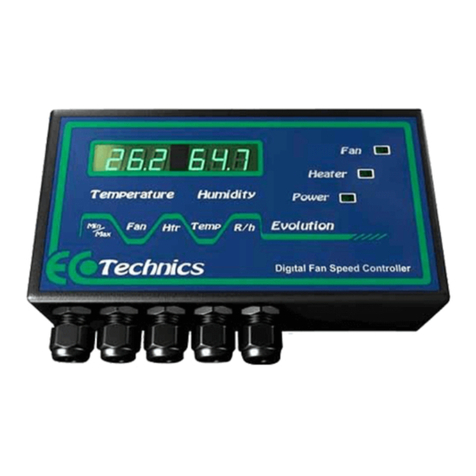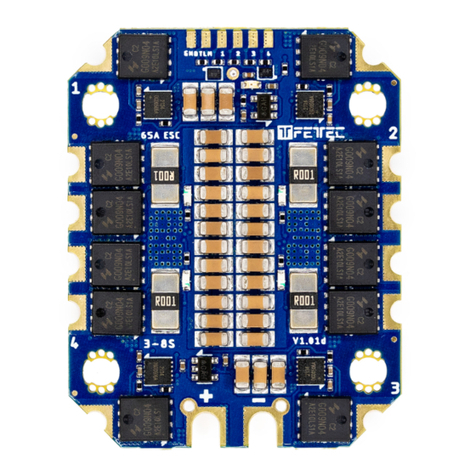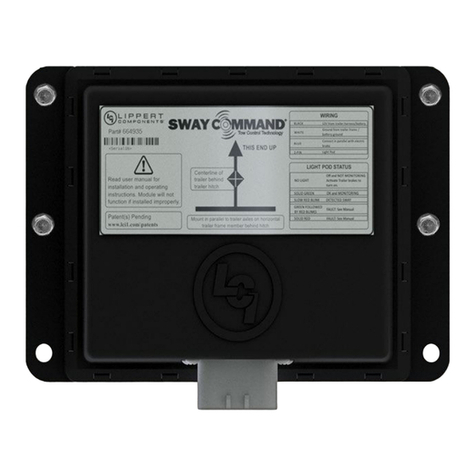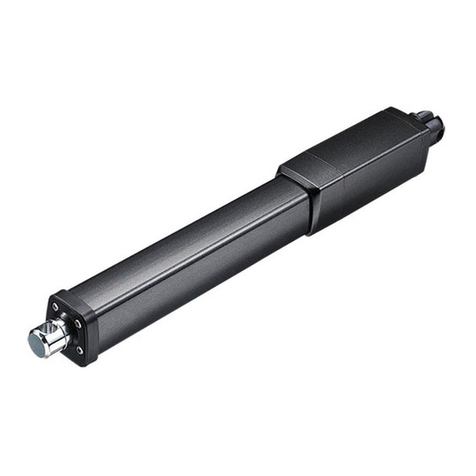CircuitWerkes Sicon-8 User manual

C
C
CI
I
IR
R
RC
C
CU
U
UI
I
IT
T
TW
W
WE
E
ER
R
RK
K
KE
E
ES
S
S
M
M
Ma
a
ak
k
ke
e
er
r
rs
s
s
o
o
of
f
f
I
I
In
n
nn
n
no
o
ov
v
va
a
at
t
ti
i
iv
v
ve
e
e
E
E
El
l
le
e
ec
c
ct
t
tr
r
ro
o
on
n
ni
i
ic
c
cs
s
s
Sicon-8
Transmitter Site Controller
Hardware Version 5a
Manual Rev 0.84
Revised 05/31/2006


Sicon-8 Technical Manual CircuitWerkes, Inc.
3
Introduction
The CircuitWerkes Sicon-8 is a value-priced, full-featured dial-up transmitter site controller with
recordable voice response and computer access capability.
1
The Sicon-8 was designed with the user in
mind, so all of the basic functionality you need to control your site is included. No extra purchases are
necessary to get your site up and running, although several options are available to expand the
capabilities of the Sicon-8.
2
See the options list below for details
or ask your favorite CircuitWerkes dealer for more info.
With eight independent channels of telemetry, status, and
control, the Sicon-8 can handle any facility with basic to
moderate control requirements. If you need more channels, the
Sicon-8 Expansion Module can be added to the system, giving a
total of 16 channels each of status, metering, and control. Each
telemetry channel provides a self-calibrating, auto-ranging
analog input capable of handling anywhere from –12V to +12Vdc
(referenced to 0Vdc). The eight control channels feature
independent relays for the raise and lower functions. The first six
control channels consist of two heavy-duty SPDT relays (one for
raise/on, one for lower/off) that can handle up to 2.5 amps at 30
VDC or 125 VAC. These relays operate in momentary mode,
making them ideal for controlling your equipment. The last two
control channels make use of two latching or momentary DPDT
relays each. These relays let you use the Sicon-8 as an audio switcher and they can also be used for
standard equipment control as well.
The Sicon-8 has many features not found in similar remote controls. For instance, the Sicon-8
makes use of voice-recordable technology, so you can record your own words and phrases in any
language, although it comes with the most commonly-used English phrases pre-configured. In addition,
a cell-phone audio interface is provided, so any auto-answer cell-phone can be used to provide control to
out-of-the-way transmitter sites. The Sicon-8 can also communicate with X10 transmitter modules. X10
modules communicate over a building's existing electrical wiring or by radio. They can be plugged in
around your site and equipment plugged into them can then be turned on or off by the Sicon-8 with no
external wiring to the remote locations.
With the Sicon-8, you're not limited to the dial-up telephone or cell phone interface. Using the
included Windows® interface software, “Sicontroller”, a local or remote computer can be used to program
or operate your Sicon-8. Programming the Sicon-8 using the software is as simple as following the menu
prompts. Sicon-8 configurations can be saved, recalled and loaded onto a single Sicon-8 or multiple
machines with ease, making setup painless for multiple sites. The Sicontroller software also allows your
Windows based PC to control your facility. The computer can connect to the Sicon-8 in one of several
different ways. With no extra hardware, a local computer can communicate with the Sicon-8 over a
standard RS-232 connection. A remote connection can be made, however, by adding either a dial-up
modem (to connect directly to the Sicon-8), or an Ethernet-to-serial adapter (see Note 1 below) to access
the device over a LAN or the Internet.
NOTE: This is a preliminary technical manual & information presented within is subject to change. Sections of
the manual dealing with the Sicontroller software & onboard Web server are incomplete and, therefore, are not
presented here. When completed, the finished manual will be mailed & available for download from our website.
1
Computer access possible using a local computer (over RS-232 connection), a dial-up modem (sold separately), or a standard
Ethernet connection. Computer access requires the CircuitWerkes Sicontroller software (included with the Sicon-8). Ethernet
connectivity for control via LAN or the Internet is made with the Etherstuff ET-1 Ethernet-to-Serial Converter, or equiv. (sold
separately).
2
Options available: 8-Channel Expansion Module (adds eight additional channels of status, telemetry, and control), Telemetry and
Status Breakout Panel (provides depluggable terminal blocks to connect status and telemetry inputs).
•Voice recordable technology
•Internet capable
•8 channels metering, status, and control
•Expandable up to 16 channels
•2 heavy-duty SPDT relays per channel
•Self-calibrating, auto-ranging meter inputs
•Up to 5 alarms per channel
•Cell-phone interface
•Audio pass-through
•Free GUI software to monitor your site
•X10 capability for additional control
Key Features

Sicon-8 Technical Manual CircuitWerkes, Inc.
4
Contacting CircuitWerkes
For help with setting up or operating the Sicon-8, please contact us at the following:
Phone: 352-335-6555
E-mail: info@circuitwerkes.com
Website: www.circuitwerkes.com
Unpacking your Sicon-8
Note: CircuitWerkes is not responsible for product damage during shipment. Inspect your
shipment carefully for external signs of damage. CircuitWerkes suggests that you unpack your
shipment as soon as possible after receipt to inspect it for signs of damage that might not be
visible from the outside. If the shipment appears to be damaged, keep the original boxes and
packing material for inspection by the carrier. All damage claims should be made directly to the
carrier. Do not delay. Call the carrier as soon as damage is discovered.
You should have received the following items with each Sicon-8 that you have purchased:
[ ] (4) depluggable screw terminal strips (12 positions each)
[ ] (12) depluggable screw terminal strips (3 positions each)
[ ] (1) Telephone cord
[ ] (1) IEC Cable
[ ] (1) Sicontroller Software CD (not yet available)
If you purchased the optional Sicon-8 Expander unit, you should have received the following items:
[ ] (4) depluggable screw terminal strips (12 positions each)
[ ] (12) depluggable screw terminal strips (3 positions each)
[ ] (1) Sicon Interface Cable
If you have not received all of the items shown with your shipment, please carefully check inside
the box or boxes because items occasionally get lost in the packing materials and can be hard to
find. If your items are not found, please call CircuitWerkes at 352-335-6555 or e-mail us at
support@circuitwerkes.com.

Sicon-8 Technical Manual CircuitWerkes, Inc.
5
Product Overview
Inputs and Outputs
As seen in Figure 1 below, the Sicon-8 has a number of connectors on the back panel to interface
the controller to your equipment. The following table is a list giving the name of each connector, followed
by a brief description of its function.
Back panel connections
Name Type Description
AC Power In IEC Cup Accepts 100-250 VAC @ 50-60 Hz.
Telco RJ-11 Connects to the phone line.
Audio In ¼” TRS
Audio input used to feed program audio into the device for
remote audio monitoring via phone.
Cell-Phone I/O 2.5mm TRS Connects to a standard cell phone headphone jack.
Audio Out ¼” TRS Audio output used for local monitoring of the device or phone
line audio.
Host/Modem Female DB-9 RS-232 connection to communicate with a host PC or modem
or LAN/Internet.
RS-232 Set 2x3 Jumpers Jumpers to set the RS-232 cable type (Normal or Null Modem).
X10 RJ-11 Connects to a Powerhouse model PL513 (or equiv) X10
transmitter for more control. Note: Not for Telephone Use.
SX-8 RJ-45 Connects to 8 channel expander chassis for extra channels.
(THIS PORT IS NOT ETHERNET)
Metering/Status Depluggable
Terminals Metering and Status inputs connect to the equipment to be
monitored. Metering is unbalanced 0 to +12V or 0 to –12V.
Status is opto-coupled & internally pulled high.
JP 514 2x4 Jumpers Selects Channel 8 Status input mode. Options: “Src” to
source Voltage to8+, “Sink” to drive the input by connecting 8-
to ground, or OFF to supply a floating Voltage to 8+ and 8-.
JP 517 2x4 Jumpers Selects the Status Inputs’ power mode. Options: “Int” to
power the inputs from the internal Sicon-8 5V power supply.
“Ext”, lets you supply up to 24V of external power to drive the
status inputs.
JP 525 Depluggable
Terminals A 3-terminal utility connector with ground, a +5V output and
the external power input for driving status inputs.
Control Output Depluggable
Terminals Control relay outputs – 12 momentary SPDT relays and 4
latching or momentary DPDT relays.
Figure 1. The back panel of the Sicon-8

Sicon-8 Technical Manual CircuitWerkes, Inc.
6
Front panel controls, indicators and inputs:
Name Type Description
Fault LED Indicator Indicates an internal failure of the Sicon-8. Contact the factory
Control LED Indicator Flashes briefly any time a relay changes state
Unlocked LED Indicator Flashes during incoming rings and is on solid when the
unlocked code is entered or when the Sicon-8 is in local mode
DTMF LED Indicator Lights when DTMF tones are being received.
-9V LED Indicator Indicates that the –9V analog supply is working
+9V LED Indicator Indicates that the +9V analog supply is working
+5V #1 LED Indicator Indicates that the +5V digital supply is working
+5V #2 LED Indicator Indicates that the +5V relay supply is working
Local Telephone Input/output This RJ-11 jack provides a means to program & operate the
Sicon-8 from the front panel. This jack is always active. See
Page 8 for complete information on how to use this port.
Remote/Local Pushbutton Toggles the Sicon-8 between local & remote modes.
Remote LED LED Indicator Flashes when the Sicon-8 is in local mode.
Output Gain Control Sets the audio output level at the rear panel ¼” Output jack.
Input Gain Control Sets the audio output level at the rear panel ¼” input jack.
Hybrid Null Adj. Control
Sets the hybrid null. This setting is important if you will be
feeding audio down the line to the caller while controlling the
Sicon-8 via DTMF tones.
See page 8 for complete instructions
on setting the hybrid null.
Table 1. Description of Sicon-8 connectors
Figure 2. The Sicon-8 front panel

Sicon-8 Technical Manual CircuitWerkes, Inc.
7
The Sicon-8 includes a Windows-based setup and control software client, the Sicontroller.
Sicontroller is divided into two main function groups, control and setup.
The setup mode lets you program your Sicon-8 via a PC. Setup is menu-driven and is designed to
make programming as easy as possible. All Sicon-8 parameters are available via the menus and, once
set-up, the programming parameters can be saved to a local file. The local file can then be used to
program other Sicon-8s or as a backup in case it ever becomes necessary to reset your Sicon-8 to
factory defaults. You may save as many Sicon-8 configurations as you want. By modifying one
configuration file and then saving it as another name, you can create an infinite number of files for setting
up different Sicon-8s.
The control mode lets you operate the Sicon-8 from either a local PC or one that is located off-site.
Sicontroller supports modem communications and Ethernet-to-serial converters for use over the Internet
or a LAN. Ethernet-to-serial converters must have software support for virtual serial ports for them to be
used with the Sicon-8.
The Sicontroller interface lets you hide any, or all, of the meter and control panels, letting you display
only the ones that you want to see.
Alarms automatically pop up a large dialog box on the screen and, optionally, play an audio alert. E-
mail can be automatically generated notifying you of the condition. The meter or status input associated
with the alarm can also be set to automatically pop-up.
Automatic logging and time-of-day functions are built into the Sicontroller. The Sicontroller can be
setup to periodically keep a text log of all meters and alarms. Meter readings can be stored on a user-
defined schedule. If an alarm condition occurs, it will be automatically recorded in the log.
The Sicon-8 has an on-board real-time clock. Basic time-of-day functions are enabled and can be
programmed via DTMF. When the Sicontroller software is released, you will have more sophisticated
access to the clock/calendar functions of your Sicon-8.
You will receive a new copy of the manual along with the Sicontroller software.
The
Sicontroller
Software is not yet
available for Sicon-8s.
The software will be
provided free when
production units are
delivered.
Figure 3.
The Sicontroller
software main display.

Sicon-8 Technical Manual CircuitWerkes, Inc.
8
Controls & Connections
Sicon-8 Main Chassis
Remote/Local: Allows you to switch operational modes. Remote mode allows normal operation of the
unit. Local mode prevents the unit from issuing commands. The Local mode is used when
performing maintenance on the equipment or setting up the Sicon-8 via the local programming port.
Remote/Local LED: Red flashing = Local mode. Off = remote mode
Local Programming Port: Powered RJ-11. Plugging a standard telephone into this port allows you to
program or operate the Sicon-8 without being on an actual telephone call. This jack is always active.
When the Sicon-8 is in remote mode (locked), you must enter the password before proceeding. After two
minutes the Sicon-8 will re-lock itself if no DTMF commands are received. This port has unrestricted
access when the Sicon-8 is in local mode, except for relay commands, which are all disabled.
Power LEDS: Red = OK, Off = Power failed for that power buss.
Fault LED: Flashing Red = Firmware or hardware problem
Unlocked LED: On when the Sicon can receive commands after a valid password is entered, as well as
while in Local mode. This LED also flashes when the incoming phone line rings.
Control LED: Briefly flashes whenever a relay changes state
Output Gain Control: Sets the level of audio that is at the Audio Output ¼” jack at the rear of the Sicon-
8. The audio at this jack will be the voice responses of the Sicon-8 and audio coming in from any active
telephone calls.
Input Gain Control: Sets the audio level being sent down the line to the caller from the rear panel audio
input jack.
Null Adjust: Sets the hybrid null. This setting is important if you will be feeding audio down the line to
the caller while controlling the Sicon-8 via DTMF tones. Setting the null is accomplished by monitoring
the Sicon-8’s audio output connection with an amplified speaker, or even an analog voltmeter. Dial up
the Sicon-8 &, enter the UNLOCK password, then trigger the built-in 1kHz test tone by entering 90 from
any menu. Adjust the Null Pot to minimize the tone level at the output jack. You may listen on an
amplified speaker or use a VU meter for this adjustment. You should not hear any significant change in
level feeding the phone line – only at the audio output jack. The null adjustment may have to be
repeated if you change phone lines attached to the Sicon-8 or if your phone lines are modified, changed,
or repaired by your telephone company. After the null is adjusted, connect your audio in and/or out
wiring. If you will not be feeding any audio to the callers, then you can probably just leave the setting at
the factory default or at the 12 o’clock position.

Sicon-8 Technical Manual CircuitWerkes, Inc.
9
Sicon-8 Rear Panel
Power: The Sicon-8 accommodates power from 100 - 240VAC at 50/60Hz.
RS232: Serial connection for direct connection to PC. Also used for firmware upgrades.
X10: Connects to a Powerhouse model PL513 (or equiv) X10 transmitter for more control. Note: Not for
Telephone Use.
Metering: Analog inputs with range of -12 to +12VDC. Auto-ranging and semi-auto-calibrating.
Status: Normally open; Sink these inputs to ground for Sicon-8 detection. Can be powered by internal
5V supply or driven from external supply to 24Vdc.
Ch8 Sel (JP-514): Selects Channel 8 Status input mode. When the jumper is set for “SRC”, you supply a
Voltage to 8+ status input to turn it on. When it is set for “Sink” you ground the 8- terminal to activate the
channel 8 status input. Do not simultaneously jumper both “SRC” and “Sink”. Leave the unused terminal
floating when either position is jumped. When both jumpers are off, the input is floating & you supply a
Voltage + and – to turn on the input.
Pwr Sel (JP-517): Selects Status Inputs Power mode. When “Int” is jumped all status optocoupler inputs are
powered by the internal Sicon-8 5V power supply. When the jumper is set to “Ext”, you can supply up to 24V
of external power to drive the status inputs. Note: Your External power supply’s ground must be connected to
the Sicon-8 ground for this to work.
Stat Pwr (JP-525): This is a 3-terminal depluggable connector with a ground, a +5V output and the external
power input for driving status inputs. The +5V output and ground can be used to drive external devices like
temperature probes. The “ext” input and ground let you connect an external power supply for driving the
status inputs. See also JP-517 above.
Telco: RJ-11 connector for on-site telephone line.
Audio Out: Audio from the telephone line appears at this balanced, 1/4” jack for possible use as
emergency audio feed to transmitter.
Audio In: Allows external audio (such as off-air monitor) to be fed to the phone line (Bal. 1/4” jack).
Safety Information
WARNING!
Serious injury or death can occur if a command channel is activated while you are performing
maintenance on your equipment. If you are performing maintenance on your equipment, you
should press the REMOTE/LOCAL button on your Sicon-8 to switch into Local mode. The LED
indicator changes to a flashing red. Local mode prevents the unit from issuing command outputs.
All metering and status information is still available to remote software users, but the Sicon-8 won't
accept incoming telephone calls until a user programmed number of rings (default = 20
th
ring) and
will not accept any commands or change the state of any of its relays. By default, the Sicon-8 cannot
remotely exit from the local mode but, it is possible to set the Sicon-8 up so that an administrator can
remotely toggle the Sicon-8 out of local mode. For additional safety it is strongly suggested that, in
addition to setting the Sicon-8 to Local mode, the remote/local switch on any transmitter or high
Voltage equipment also be set to the local mode.

Sicon-8 Technical Manual CircuitWerkes, Inc.
10
CAUTION: While the Sicon-8's relays are physically capable of handling 250 VAC, this practice is very
dangerous and should never be attempted. The terminal strips are not designed to shield humans
from potentially dangerous Voltages. Contact with high Voltages can cause serious injury or death.
The maximum recommended Voltage for the Sicon-8 is 30V. Switching of high voltages should only
be done externally and in a manner that isolates the voltages from accidental contact with people.
Surge Protection
Although the Sicon-8 has built-in resistance to voltage changes, we recommend that you use a
power surge protector or line conditioner on the incoming AC line. Lightning strikes and other high
surges in voltage levels will damage your Sicon-8 and connected equipment if it is not properly
protected.
UPS Standby Power System
We recommend that you connect your Sicon-8 to a battery backup system. The Sicon-8 will then be
able to notify you of the power outage by phone, pager, or data, depending on the
configuration of your system.
Connecting your Sicon-8 to other equipment6
The Sicon-8 is equipped with 16 relays organized in 8 channels to provide you with control over your
transmitter site equipment. Each channel consists of a raise/on relay and a lower/off relay. These raise
relays are used to turn equipment on or to raise a given parameter, like power, for instance. Similarly,
the lower relays are usually used to turn equipment off or to reduce the specified parameter. These
relays can be used to control any equipment in any way, but it is recommended, for the sake of simplicity,
that equipment is turned on or parameters increased using the raise relays and equipment turned off or
parameters lowered with the lower relays.
The first six channels consist of heavy-duty SPDT relays, rated at 3 A @ 30 VDC or 3 A @ 250 VAC,
which operate in momentary mode. Although these relays are rated to handle up to 250 VAC, it is
forbidden to do so due to the dangers associated with exposing such high voltages. Hazardous
voltages must be switched with slave relays or equivalent in an isolated enclosure that prevents
anyone from accidentally making contact with the high voltage. Three contacts are made available
on the back panel for each of these relays, the common line the normally-open and the normally-closed
contact.
Channels 7 and 8 each consist of two DPDT relays (one for raise/on and one for lower/off) which
can operate in momentary or latching mode. These relays can tolerate up to 1 A @ 30 VDC or 0.3 A
@ 125 VAC (again, connecting high voltages to the Sicon-8 is dangerous and must not be done.)
Since these relays may operate in the latching mode, they are ideal for use as a simple, stereo,
audio switcher. These relays can also be operated in momentary mode, so they can be used as
standard control outputs, as well. All six contacts of each relay are brought out on the back panel
barrier strip, so any and all of their contacts may be utilized.
Once your equipment has been connected to the Sicon-8, insert the push-on connector into the
back-panel connector on the Sicon-8, with the set screws facing up.
WARNING! Double check that you have connected your equipment to the correct Sicon-8 relays.
Count the screw terminals on your depluggable connector to be sure that the wires are in the
correct positions and that you have inserted the connector into the right connector bank. It is
recommended that you only unplug one connector at a time to avoid accidentally swapping them.
Incorrect wiring can cause command failure or damage to your equipment.

Sicon-8 Technical Manual CircuitWerkes, Inc.
11
Metering & Status Connections
Eight metering channels are brought into the Sicon-8 on a depluggable euro-connector located at the center of the
back panel (see Figure 2 above). These analog inputs can handle either positive or negative voltages of up to 12 Volts,
however all inputs must be ground referenced by connecting your metering ground to the Sicon-8's ground. To make
setup and operation simpler, each input is auto-ranging. You do not have to adjust any potentiometers to set the proper
input range. Inputs are self-calibrating and are based on an internal, precision, low-drift, voltage reference, so the meters
will not drift over time or with temperature. Metering setup is as simple as connecting the sample voltage and then telling
the Sicon-8 what the input voltage represents. DO NOT CONNECT SAMPLE VOLTAGES IN EXCESS OF 12V OR
DAMAGE MAY OCCUR TO YOUR SICON-8.
Floating Grounds
Except for status input #8, none of the Sicon-8’s metering or status inputs will accept a floating ground.
Damage to the Sicon-8 or your equipment may result from connecting a floating ground output to the Sicon-8.
If you must use a metering or status inputs with equipment that has a floating ground, an isolation amplifier
must be used.
The Sicon-8's optically-isolated status inputs can be used to determine the status (on/off) of your
equipment. The status input connector is located immediately to the right of the metering connector and the
first seven status channels accept only contact closures as inputs. If the voltage at the input is at or very near
ground, then the status channel is considered active, and if it is ungrounded, the channel is considered
inactive. The logic can be reversed on each channel, in firmware, so that the status is considered active when
ungrounded. You can also choose to disconnect the Sicon-8's internal 5V supply and source your own
Voltage (up to 24V) to inputs 1-8. To Source Voltage, you must first move the “PWR SEL” jumper (JP517)
from “Int” to “Ext”. Be sure to never jumper both simultaneously. Then you connect your Voltage source to the
Ext input and ground of the “Stat Pwr” (JP-525) connector located just to the right of JP517. Internal 5V is also
brought out to the “Stat Pwr” connector should you want to use it for powering temperature probes, etc. Never
connect up an external Voltage source to the status inputs without moving Jumper JP517 to “Ext”.
Regardless of whether you use the internal Voltage source or your own, your equipment's ground must be tied
to the Sicon-8's ground.
In addition to the ability to source an external Voltage to the status inputs, the eighth status channel provides
some additional flexibility. Based on the “Ch8 SEL” (JP-517) jumper setting, you may configure channel 8 so
that your equipment sources current to or sinks current from the Sicon-8. In either case, if current is flowing,
then the input is considered active, but again, this may be inverted according to your preferences. If both
jumpers are removed from JP-517, you can supply your own, floating Voltage to channel 8’s + and – inputs. If
you don't want to source your own current to status channel 8, one line is provided with +5 V. This line is
diode-protected and current-limited. It is not required that a +5V line be used to source current to channel 8. It
will tolerate up to 24 VDC as input, but at least 3 VDC is needed to turn the optoisolator on. The status inputs
will not accept AC Voltages. If an AC input is required, a bridge rectifier with a small capacitor at its output
should be used to convert the sample to DC before connecting it to the Sicon-8's status input. As noted above
under metering, except for status input #8, connecting a floating ground to your unit may result in damage to
the Sicon-8 or the device that is connected to the Sicon-8. It will may also result in erroneous readings or
status indications.
Fig. 2 - Sicon-8 Back Panel
Diagram

Sicon-8 Technical Manual CircuitWerkes, Inc.
12
Before Programming the Sicon-8…
The Sicon-8 has been designed to make programming through the dial-up interface easier than
previous talking remote controls. Among the many improvements in the Sicon-8 is the ability to do
all of the math calculations common in other devices. You will not need to perform any multi-step
math problems in order to get the Sicon-8 to accurately read your meters. Despite the Sicon-8’s
many improvements, it is still a complex piece of equipment and, if you want to take full advantage
of the many cool features of the Sicon-8, you may well find that it is helpful or necessary to make
notes of what words are stored in specific locations. If using the alarm dialers, you may also want to
keep track of the phone numbers that you program into the master dialer memory for easy recall
when programming more than one alarm dialer. Additionally, you might want to keep track of the
telephone numbers that you associate with each channel’s alarms.
Most of the DTMF control & programming information in this manual assumes that you are calling
the Sicon-8 from an outside telephone line, however, the Sicon-8 can also be accessed from the
front panel, powered, RJ-11. This front panel jack is intended for you to plug a standard telephone
into for local programming. It has no connection to the actual telephone line and a phone line should
NEVER be plugged into the local programming port or damage may result to the Sicon-8 or the
phone line. If you are programming the Sicon-8 from the local port AND the Sicon-8 is in local
mode, you will not have to enter a password to check meter readings or enter any of the setup
menus of the unit. While in the local mode, you will not be able to operate any relays, but all other
functions are available to you. If the Sicon-8 is in remote mode, you will be required to enter a valid
password before the unit will accept commands. The only user password that is factory set is 6736
for the Super-Administrator.
The Sicon-8 is pre-programmed with a basic English word set that is designed to make operating it
possible without spending a lot of time setting up its vocabulary. It is also programmed with some
simple configuration data that is intended to make the Sicon-8 useable right away for simple control
& metering. Although the Sicon-8 will function right out of the box, there are a few basic functions
that you will need to program before using the device. We highly suggest that you start by
modifying the user password to something of your choosing. You will also need to, at the least, set
up and calibrate the meters of the Sicon-8 in order to get useful data from your equipment.
How words & phrases are used in the Sicon-8:
The Sicon-8 stores each voice response in its own distinct memory location, so instead of stringing a
list of predefined words together to generate the desired response, you simply record (either over
the phone line or program it using your PC) the desired response into the appropriate location. For
example, when the Sicon-8 answers the phone, it speaks the Site Label back to you. By default, the
Sicon will say, "Hello. Enter password." To change the Site Label, you only need to record a new
phrase into the corresponding memory location. In this way, the Sicon's voice responses are not
limited by the predefined words stored in memory. Rather, you can record any phrase you want into
any memory location.
It is important to realize, however, that certain phrases are used in various circumstances. For
instance, when reading a meter value back to you, the Sicon accesses the memory locations which
store the various numbers, the word, "point", and the channel's unit label. If the meter value is 4.89
kiloWatts, then the Sicon will say "four" "point" "eight" "nine" "kiloWatts", with each word being stored
in a separate memory location. For this reason, you generally do not want to change the meaning of

Sicon-8 Technical Manual CircuitWerkes, Inc.
13
the phrases stored in these locations, though changing the language would be just fine. For
example, if the word "truck" were recorded into the location where "four" is normally stored, then the
Sicon would read back "truck" "point" "eight" "nine" "kiloWatts". Obviously, this doesn't make much
sense.
It is usually only necessary to re-record the phrases corresponding to the Meter Labels, Status
Labels, Unit Labels, and Site Label, since each user will configure their Sicon differently. Meter
Labels are spoken immediately before reading a meter value, so if Meter 1 corresponds to the
Transmitter Power Output, then you would record "Transmitter Power Output" into Meter Label 1.
Similarly, Status Labels are spoken before a given channel's status value is read. Each channel has
its own distinct Meter and Status Labels. A Unit Label is spoken immediately after the meter value
has been read, and is used to identify the units being measured. In the above example, the Unit
Label is "kiloWatts". The Site Label is the phrase which is spoken right after the Sicon answers the
telephone line. Some users may want to record silence into this location, so a malicious caller will
not recognize the need to enter a password.
The factory programmed defaults for the Sicon-8 are as follows:
Passwords
DTMF Super-Admin PW = 6736
Serial Super-Admin PW = 12345678 (ASCII characters)
Remote/Local Toggle password = 1379
* Meters
All meters are configured for direct linear mode with units set to volts
* Status
Status polarity is set to normal
Status alarms are set as warning, but they're disabled
* Alarms
Global alarms are enabled
All individual alarms are disabled
Alarms are not configured
* Phone numbers
Master phone number list and individual alarm lists are cleared (no valid phone numbers)
* Other settings
Remote ring limit = 2 rings
Local ring limit = 20 rings
Max. number of incorrect DTMF passwords before hang-up = 3
Remote/Local toggle is disabled
Unit is not expanded (no SX-8 Chassis Attached)
Alarm dial-out is enabled
Cell-phone interface is disabled
* Timers (NOTE: These are currently not configurable)
DTMF inactivity timer = 2 minutes
+ The amount of time that can elapse without receiving a valid DTMF tone until the unit
hangs up
Power-up timer = 5 minutes
+ The amount of time after power-up until the unit begins checking alarms
Wait for reference timer = 1 minute
+ The amount of time to elapse after requesting a reference reading until the reference
reading is actually taken

Sicon-8 Technical Manual CircuitWerkes, Inc.
14
Fixed warning verification time = 1 minute
+ The amount of time an input must stay within tolerance after a warning alarm attempts to
fix the condition until the alarm is considered fixed
Fixed warning wait time = 30 Seconds
+ The amount of time after attempting to fix a warning alarm until the alarm channel is
checked again
Alarm valid time = 30 seconds
+ The amount of time a warning alarm must be out of tolerance before the alarm is
considered active
Password entry timer = 30 seconds
+ The amount of time that can elapse without receiving a valid DTMF tone while waiting
for a password until the unit hangs up.
Dial-out acknowledgment time = 30 sec
+ When dialing out for a critical alarm, the Sicon will wait this amount of time for a user to
log in before hanging up
Redial time = 2 minutes
+ When dialing out, the unit will wait this amount of time before dialing the next number
Audio enable time = 15 seconds
+ When the user enters the command to listen to the audio in, the audio will be present for
this maximum amount of time
Autoscan time between channels = 2 seconds
+ When performing an autoscan, the unit will pause for this amount of time between
reading each channel.
Operating/Programming Your Sicon-8
Dial-Up Use
The voice connection requires only a telephone line routed from your wall jack to the TELCO jack on
the Sicon-8. It is highly recommended to route the telephone line through a TELCO surge
suppressor before plugging it into the Sicon-8.
The Sicon-8 will auto-answer your incoming call after a user-set number of rings. Once the Sicon-8
answers the incoming call, it will say “Enter password”. The Sicon-8 will allow three attempts to
enter your password. If you fail to correctly enter the password three times or take more than 30
seconds to enter your password, the Sicon-8 will automatically hang up. A “#” must be entered at the
end of the password being used when using DTMF tones. The default dial-up password for the
Sicon-8 is 6736 which spells “open” on a standard DTMF keypad. It is highly suggested that you
change this password since this manual is published online. See system setup (#91, 71) on page
21 for instructions on changing or adding passwords.
Once you have correctly entered your password you now have DTMF tone control of the Sicon-8.
Using your DTMF telephone, you can tell the Sicon-8 to get meter readings, check status input
states, check and/or clear alarms, issue commands via the relays or, if your access level is
Administrator, you can also program the various functions of the Sicon-8.
As soon as the password has been correctly entered, you will be at the main menu. The main menu
has fourteen possible commands that are currently available. They are:

Sicon-8 Technical Manual CircuitWerkes, Inc.
15
00 - AutoScan active channels for readings
01 thru 16 - Select a channel to read/control
65 - X10 On Commands (01 thru 16)
66 - X10 Off Commands (01 thru 16)
90 - Play 15-Second Test Tone
91 - Enter System Setup Menu (where all user programming is done – See pp21-26).
92 - Report alarms
93 - Report unread alarms
94 - Toggle remote/local mode (requires special password)
95 - Turn on audio monitor for 15 seconds
96 - Report firmware version
97 - New Login (requires entering a valid password
98 - TAD (telephone answering device) mode
99 - Immediate hangup command
Main menu commands are global. In other words, they are available from the “main menu” or from
any of the sub-menus. Submenu commands are available only while in that sub-menu. Each of the
above sub-menus is explained below.
00 – AutoScan. This command reports the status & meter readings for each active channel. An
active channel is one that has been selected during setup to be part of the AutoScan channel list.
See the channel setup sub-menu for how to enable AutoScan for each channel.
01 –16 – Channel menu:
When you enter a channel, the Sicon-8 immediately reports all parameters for that channel. You
may enter a DTMF command at any time during the channel report and the Sicon-8 will stop its
report and perform the requested function. Available commands are:
70: AutoScan channel enable (Individual channel alarms require AutoScan enabled)
71: Calibrate and setup meter
72: Set status mode (normal/inverted)
73: Setup alarm
74: Enable/Disable alarm dialing
75: Setup critical alarm phone numbers
76: Jump to (or return to) the alarm stack
77: Reads the meter for that channel
78 - Set relay mode; momentary or latching (channel 7,8,15 & 16 only)
79 - Enable/disable tied relays
80: Record the meter label for the current channel
81: Record the status label for the current channel
88: Reads the status input for that channel
*
- Operates the channel’s RAISE relay for the duration of the DTMF tone.
# - Operates the channel’s LOWER relay for the duration of the DTMF tone.
NOTE:
For your reference when configuring words, there is a list of all words in Appendix A at the back of
the manual. Also, there is a list of the default words assigned to the “Units” words on the last page
of this manual, before appendix A.

Sicon-8 Technical Manual CircuitWerkes, Inc.
16
Channel Menu Instructions:
70 – AutoScan mode/Channel Alarm enable: This function lets you add or remove the current
channel to the group of channels that are spoken during a channel AutoScan (00). Autoscan
must be enabled for a channel to report alarms. Enter Zero (0) to attach this channel
to the AutoScan group. Enter One (1) to disable scanning of this channel. Example: 70, Sicon
beeps, 0, Sicon beeps twice. This channel is now part of the AutoScan group and AutoScan
setup is now ended. You must enter 70 again if you change you mind. Removing a channel from
Autoscan can be a convenient way to silence all alarms on that channel. See also #74 for disabling specific alarms.
71 – Setup metering. This function lets you configure various metering modes and values.
When entering the meter setup mode you have five initial options:
0 = Linear metering mode. (this mode is direct reading without scaling- Like a talking Voltmeter)
1 = Linear with “scaling” metering mode. This is the most common metering mode.
2 = Reserved for future
3 = Power mode. For reading power meters. This is the second most common type of metering mode.
4 = Log scale mode
5 = Indirect Calculation. This mode uses two metering inputs and a multiplier to calculate a value. Indirect mode is
commonly used to calculate a radio or TV station’s operating power as specified in the license. One channel must be the
currently selected channel. You must provide an input sample to the channel for the Sicon-8 to use. For instance, if you
have transmitter plate Voltage on meter # 1 and Plate current on meter #2, you must parallel either the plate Voltage or the
plate current sample to the currently selected metering channel. The Sicon-8 will be multiplying the current metering
channel input with the other channel and applying a scaling factor to calculate the reading.
Setup: Sicon-8 beeps once. Choose the
units identifier by selecting 0 to 9. Sicon
beeps twice.
Setup is identical to “Linear with Scaling above
: The Sicon-8 beeps once. Enter actual value of the physical
meter (the appropriate meter on the transmitter) that is associated with this channel. The Asterisk (*) places a
decimal. Use the # key to end the entry. The Sicon-8 speaks the value that you entered back. Press 1 to confirm
or 0 to re-enter. The Sicon-8 will take a sample reading, AutoScale its meter and then beep once. Choose the
units identifier by selecting 0-9. The Sicon-8 beeps twice indicating completion of that metering channel setup.
.
Setup: The Sicon-8 beeps once. Enter actual value of the physical meter (the appropriate meter on the
transmitter) that is associated with this channel. The Asterisk (*) places a decimal. Use the # key to end the
entry. The Sicon-8 speaks the value that you entered back. Press 1 to confirm or 0 to re-enter. The Sicon-8 will
take a sample reading, AutoScale its meter and then beep once. Choose the units identifier by selecting 0-9.
The Sicon-8 beeps twice indicating that metering setup for that channel has been completed.
Setup is identical to “Linear with Scaling above
: The Sicon-8 beeps once. Enter actual value of the physical
meter (the appropriate meter on the transmitter) that is associated with this channel. The Asterisk (*) places a
decimal. Use the # key to end the entry. The Sicon-8 speaks the value that you entered back. Press 1 to confirm
or 0 to re-enter. The Sicon-8 will take a sample reading, AutoScale its meter and then beep once. Choose the
units identifier by selecting 0-9. The Sicon-8 beeps twice indicating completion of that metering channel setup.
Setup: The Sicon-8 beeps once. Enter the
two digit channel number that the Sicon-8 will use for the multiplier. The
Sicon-8 will then beep once. Enter the value of the meter connected to the current channel. The Asterisk (*) places a
decimal. Use the # key to end the entry. The Sicon-8 speaks the value that you entered back. Press 1 to confirm or 0 to
re-enter. The Sicon-8 will beep once. The Sicon-8 will then beep once. Choose the units identifier FOR THIS
CHANNEL by selecting 0-9. The Sicon-8 beeps twice indicating completion of that metering channel setup.

Sicon-8 Technical Manual CircuitWerkes, Inc.
17
72 - Set Status “polarity”. - Enter 0 for normal (status is considered “ON” when grounded). Enter 1 for inverted (status is
considered “ON” when input is open or ungrounded). Example: 72, Sicon beeps, 0, Sicon beeps twice. Polarity setup
is now ended. You must enter 72 again if you change you mind.
73 – Alarm Setup. - This function lets you set the number and type of alarms for the currently active channel. Each
channel can have up to five alarms (upper & lower warning, upper & lower critical & a status alarm). Alarms may be
set for either over-value or under-value. An over-value alarm is one that exceeds a pre-programmed value that you
have specified. Conversely, an under-value alarm is one that drops below a pre-programmed value that you have
specified. Alarms may be either “warning” or “critical”. A warning alarm can cause the Sicon-8 to attempt to correct a
situation by operating a relay. Warning alarms are reported if they still exist when the user dials in, but don’t initiate
outbound calls. Critical alarms make outbound telephone calls, but do not operate relays. The Sicon-8 attempts to
rectify warning alarms up to three times, then stops. It also stops if any new alarm occurs while a warning alarm is still
pending or if a user calls in while the alarm is still pending. In that case, all current alarms go on the new alarm stack.
Setup: Enter the alarm type 1-6 as follows:
1 = Metering low warning alarm (does not call, but can activate a relay)
2 = Metering high warning alarm (does not call, but can activate a relay)
3 = Metering low critical alarm (dials out & stops any automatic action of warning alarms)
4 = Metering high critical alarm (dials out & stops any automatic action of warning alarms)
5 = Status warning alarm (does not call, but can activate a relay)
6 = Status critical alarm (dials out & stops any automatic action of warning alarms)
For metering alarms 1-4 you must now enter the alarm limit value. Asterisk (*) set a decimal and a Pound (#) must be
used to end the value. The Sicon-8 speaks the value that you entered back to you. Press 1 to confirm or 0 to re-enter.
For Status input alarms (5-6) 0 = alarm is activated when the input is grounded. 1 = alarm is activated when the input is
open. Note: The channel polarity can be reversed in software which also inverts the alarm.
For all warning alarms you must specify a relay channel, raise (*) function or lower(#) function, and the desired duration
of the contact closure in seconds. You may enter fractions of a second by using the asterisk (*). End the time setup with
the #. To de-activate relay operation enter a zero (0) instead of a relay channel number. Warning alarms are fixed in
order of occurrence.
For all critical alarms, you specify the two digit telephone dialer memory location that contains the telephone number you
wish to dial. You may specify up to five dialing sequences. Enter a # when finished.
Example #1 – To set up a high metering warning alarm on the current channel, the sequence might go like this:
You enter DTMF 73. Sicon beeps. You enter 2. Sicon beeps. You enter a number like 10*50# which corresponds to
10.5kW. The Sicon-8 speaks the value that you entered back. Press 1 to confirm or 0 to re-enter. The Sicon-8 beeps.
Enter 01 (the channel you will activate, in this case channel 1). Enter # (the lower relay command). Enter 3*5 (for 3.5
seconds). The Sicon-8 confirms the time value by speaking “3-point-5” back to you. Confirm by entering a 1 or re-enter
the value by pushing a 0. If the meter detects a high warning alarm condition, the Sicon will now close channel one’s
relay for 3.5 seconds. It will take a reading to see if the condition still exists. If it does still exist, the Sicon will then try
twice more to correct the problem. The full programming sequence for this example is: 73,2,10*50#,1,01,3*5#,1.
Example #2 – Set the current channel’s status input as a critical alarm:
Enter DTMF 73. Sicon beeps. You enter 6. Sicon beeps. Enter 0 (this alarm will activate if its input is grounded).
Sicon beeps. Enter 01 (this assumes you want to use the telephone number that you have stored in memory 01. You
can use 01 thru 20). Sicon beeps twice indicating that you have successfully programmed the alarm. The complete
programming sequence for this example is: 73,6,0, 01#. To add additional dialer numbers the sequence might be:
73,6,0, 01,02,03#. The alarm could also be activated when ungrounded by entering a 1 after the 6 instead of a 0.

Sicon-8 Technical Manual CircuitWerkes, Inc.
18
Channel Menu Continued
74 - Enable/Disable alarm.
First, enter the alarm type, then enter 1 to enable the alarm reporting or 0 to disable the alarm
reporting. Example: 74, Sicon beeps, 0, Sicon beeps twice. Alarm reporting is disabled and
setup is now ended. You must enter 74 again if you change you mind. To turn off all alarm
reporting for a specific channel, consider removing it from the autoscan function using the 70
command.
75 – Quick Setup Alarm dial numbers. -
To setup the phone numbers for a critical alarm, first enter the command (75) followed by the
one-digit alarm type. The alarm type must correspond to a critical alarm. That is, it must be
either 3 (low critical), 4 (high critical), or 6 (status critical). Then enter a series of up to five two-
digit numbers corresponding to the phone number memory location (01-20). To terminate the
list before using all five phone numbers, enter the number sign (#).
77- Read Meter
This command causes the Sicon-8 to read back the meter associated with the current channel.
78- Set relay mode (for channels 7, 8, 15 or 16 only)
This mode lets you set the relays on these channels to momentary or latching mode.
Momentary mode works just like all other relays on the Sicon-8, except that the relays on these
channels are the DPDT type with two sets of normally open and normally closed contacts per
relay. Latching mode causes a relay to be energized until their off code is received. If a power
failure occurs, latching relays will return to their previous state when power is restored. (Default:
All relays momentary)
79 - Enable/disable tied relays
This mode lets you tie the raise & lower relays together allowing
both to operate from a common command. When the relays are tied together, the “lower” relay
follows the programming & activation command of the “raise” relay. This command works for
latching relays as well as the momentary ones. This mode is handy for switching stereo audio.
If tied together, the raise relay mode determines the operation of both relays.
(Default: All channels disabled)
To set the relay mode:
1. Enter 78 while channel 7, 8, 15, or 16 is selected.
2. Enter the relay mode for the raise relay (0 = momentary, 1 = latching).
3. Enter the relay mode for the lower relay. Note: when relays are latched, two digits
are required to operate them. See “Relay Commands” at the end of this section
for details.
To enable/disable tied relays:
1. Enter 79 (this can be done on any channel).
2. Enter 0 to operate each relay independently or 1 to tie the relays together.

Sicon-8 Technical Manual CircuitWerkes, Inc.
19
Channel Menu Continued
80 - Record meter label
81 - Record status label
88 – Read Status input - This command causes the Sicon-8 to read back the current channel’s
status input level.
Relay Commands
Serious injury or death can occur if a command channel is activated while you are performing
maintenance on your equipment. If you are performing maintenance on your equipment, you
should press the REMOTE/LOCAL button on your Sicon-8 to switch into Local mode. The LED
indicator changes to a flashing red. Local mode prevents the unit from issuing command outputs.
All metering and status information is still available to remote software users, but the Sicon-8 won't
accept incoming telephone calls until a user programmed number of rings (default = 20
th
ring) and
will not accept any commands or change the state of any of its relays. By default, the Sicon-8 cannot
remotely exit from the local mode but, it is possible to set the Sicon-8 up so that an administrator can
remotely toggle the Sicon-8 out of local mode. For additional safety it is strongly suggested that, in
addition to setting the Sicon-8 to Local mode, the remote/local switch on any transmitter or
high Voltage equipment also be set to the local mode.
Relay Operation
The Sicon-8 employs six channels (1 thru 6) of SPST relays. The remaining two channels (7 & 8)
have DPDT relays. Normally, each relay operates independently of all others. Relays are also
configured for momentary operation. Under independent & momentary operation the following
applies to all relays:
* - An asterisk (star) operates the current channel’s RAISE relay for the duration of the DTMF tone
# - Pound operates the current channel’s LOWER relay for the duration of the DTMF tone
1. Press and hold *
2. When * is released, the Sicon begins recording.
3. The Sicon stops recording either when any DTMF tone is entered, or the end of the phrase time
is reached.
4. At this point, the Sicon will play back what was recorded.
5. If you're satisfied with the recording, enter 0. To re-record the phrase, enter 1. This will take
you back to step 1.
1. Press and hold *
2. When * is released, the Sicon begins recording.
3. The Sicon stops recording either when any DTMF tone is entered, or the end of the phrase time
is reached.
4. At this point, the Sicon will play back what was recorded.
5. If you're satisfied with the recording, enter 0. To re-record the phrase, enter 1. This will take
you back to step 1.
WARNING!

Sicon-8 Technical Manual CircuitWerkes, Inc.
20
Relay Operation Continued
Special relay command modes
There are two special modes of operation available: The DPDT relays can be operated in latching or
momentary mode. Any channel can have its raise & lower relays locked together so that they both
operate from a single command, determined by the mode of the raise relay.
When the raise & lower relays are locked together in momentary mode, the asterisk (*) operates
both relays.
Raise & lower relays on channels 7 & 8 can be latched independently of each other or set to operate
together as in the case of the previous six channels. Four sub-modes of operation are possible for
relays on channels 7 & 8. Note that, in most cases, latching relays require a two-digit command to
turn them on & another two-digit command to turn them off.
When in independent latching mode for both relays on a channel, *1 latches the raise relay
and *0 unlatches the raise relay. #1 latches the lower relay while #0 unlatches it.
When the raise relay is in latching mode and the lower relay is momentary, then *1 latches
the raise relay and *0 unlatches the raise relay. # closes the lower relay for the tone
duration.
When the raise relay is in momentary mode and the lower relay is latching, then # closes
the raise relay for the tone duration. #1latches the lower relay and *0 unlatches the lower
relay.
When relays 7 and/or 8 are in latching mode and the raise & lower relays are locked
together, then * latches both relays and # unlatches both relays (exception to 2-digit rule).
When relays 7 and/or 8 have their raise & lower relays are locked together, the mode that is
programmed into the raise relay determines the mode of operation for both relays. Any time that
both relays are locked together, they are always controlled by a single (*) for momentary or a single
(*) for ‘ON’ and a single (#) for ‘OFF’ when in latching mode.
************************ End of Channel Menu Commands ******************************
65 – X10 ‘On’ Commands (see also System Setup Menu commands # 83 & 84)
Allows you to turn on specific X10 devices by entering their two-digit unit number (01 - 16). For
example, 6501 turns on the first X10 device. 6502 turns on the second device, etc. Note that the
house code must have already been set up in advance.
66 – X10 ‘Off’ Commands
Allows you to turn off specific X10 devices by entering their two-digit unit number (01 - 16). For
example, 6601 turns off the first X10 device. 6602 turns off the second device, etc.
90 – Play 15 Second Test Tone
This command plays a 15-second, 1-kHz tone, which can be used to adjust the hybrid null.
If the user enters a DTMF tone while the 1-kHz tone is playing, the 1-kHz tone will
immediately stop. This command can be executed from any menu by entering 90
Other manuals for Sicon-8
2
Table of contents
Other CircuitWerkes Controllers manuals
Popular Controllers manuals by other brands
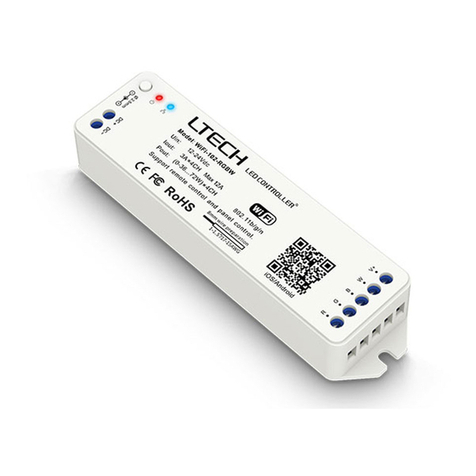
Ltech
Ltech WiFi-RDM01 operating instructions
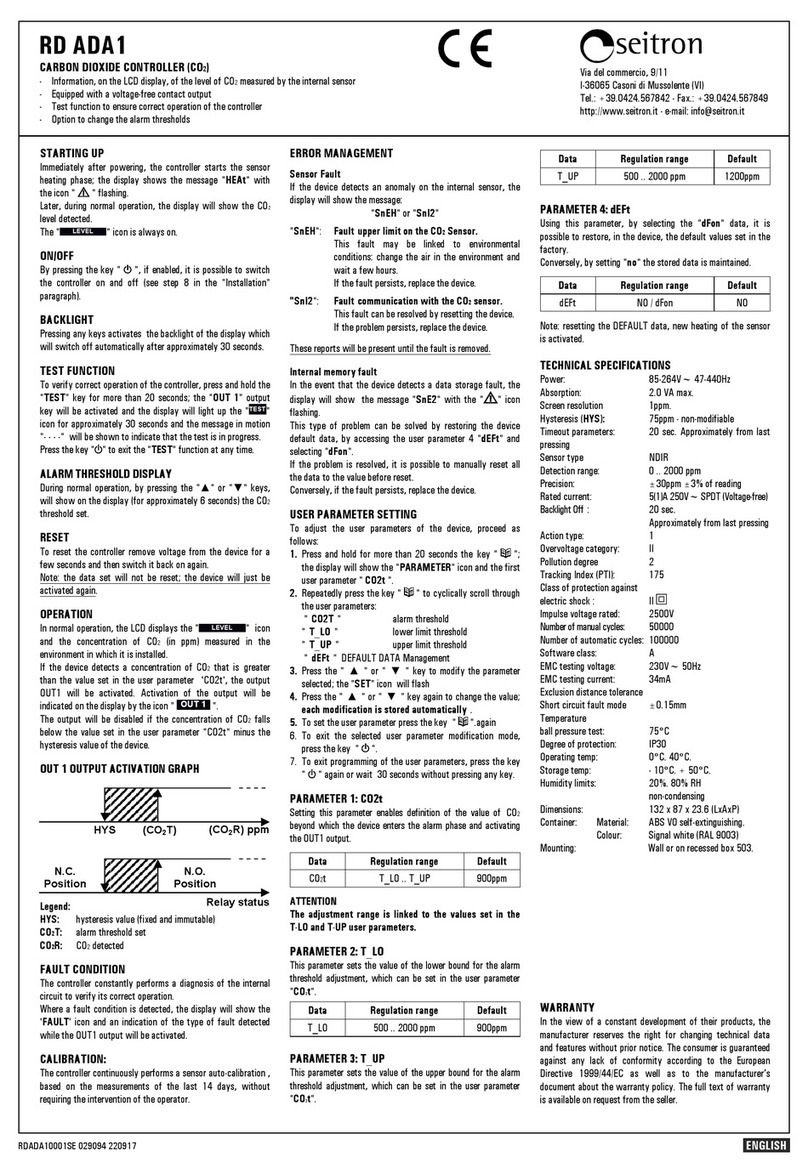
Seitron
Seitron RD ADA1 quick start guide

FASAR ELETTRONICA
FASAR ELETTRONICA FE230/T manual
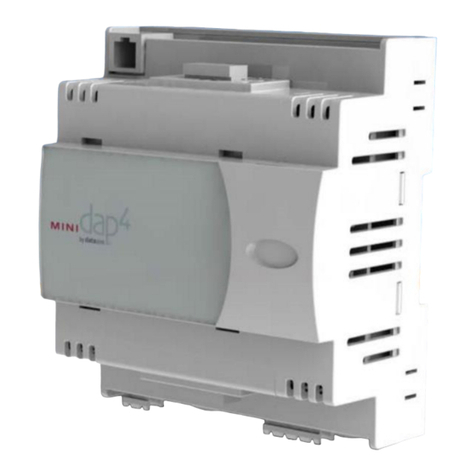
Data Aire
Data Aire Mini dap4 Installation, operation & maintenance manual
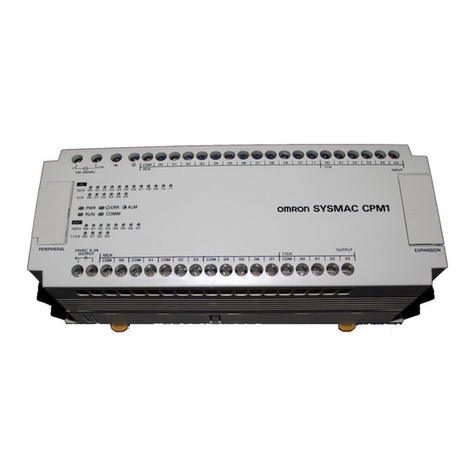
Omron
Omron CPM1 - PROGRAMING 02-2001 Programming manual
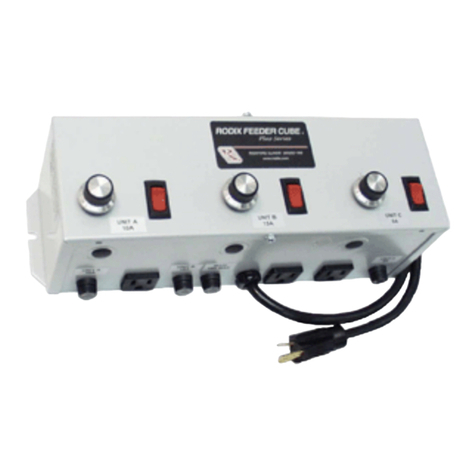
Rodix
Rodix 121-000-0893 quick start guide


